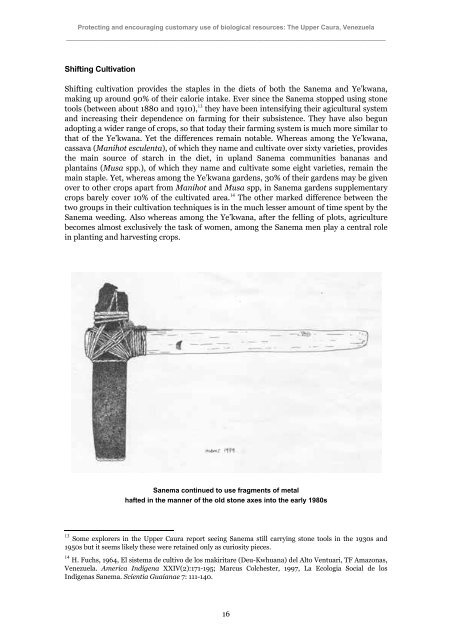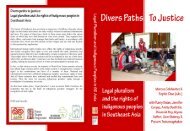The Upper Caura, Venezuela - Forest Peoples Programme
The Upper Caura, Venezuela - Forest Peoples Programme
The Upper Caura, Venezuela - Forest Peoples Programme
Create successful ePaper yourself
Turn your PDF publications into a flip-book with our unique Google optimized e-Paper software.
Protecting and encouraging customary use of biological resources: <strong>The</strong> <strong>Upper</strong> <strong>Caura</strong>, <strong>Venezuela</strong>_________________________________________________________________________________________Shifting CultivationShifting cultivation provides the staples in the diets of both the Sanema and Ye’kwana,making up around 90% of their calorie intake. Ever since the Sanema stopped using stonetools (between about 1880 and 1910), 13 they have been intensifying their agicultural systemand increasing their dependence on farming for their subsistence. <strong>The</strong>y have also begunadopting a wider range of crops, so that today their farming system is much more similar tothat of the Ye’kwana. Yet the differences remain notable. Whereas among the Ye’kwana,cassava (Manihot esculenta), of which they name and cultivate over sixty varieties, providesthe main source of starch in the diet, in upland Sanema communities bananas andplantains (Musa spp.), of which they name and cultivate some eight varieties, remain themain staple. Yet, whereas among the Ye’kwana gardens, 30% of their gardens may be givenover to other crops apart from Manihot and Musa spp, in Sanema gardens supplementarycrops barely cover 10% of the cultivated area. 14 <strong>The</strong> other marked difference between thetwo groups in their cultivation techniques is in the much lesser amount of time spent by theSanema weeding. Also whereas among the Ye’kwana, after the felling of plots, agriculturebecomes almost exclusively the task of women, among the Sanema men play a central rolein planting and harvesting crops.Sanema continued to use fragments of metalhafted in the manner of the old stone axes into the early 1980s13 Some explorers in the <strong>Upper</strong> <strong>Caura</strong> report seeing Sanema still carrying stone tools in the 1930s and1950s but it seems likely these were retained only as curiosity pieces.14 H. Fuchs, 1964, El sistema de cultivo de los makiritare (Deu-Kwhuana) del Alto Ventuari, TF Amazonas,<strong>Venezuela</strong>. America Indígena XXIV(2):171-195; Marcus Colchester, 1997, La Ecologia Social de losIndigenas Sanema. Scientia Guaianae 7: 111-140.16
















